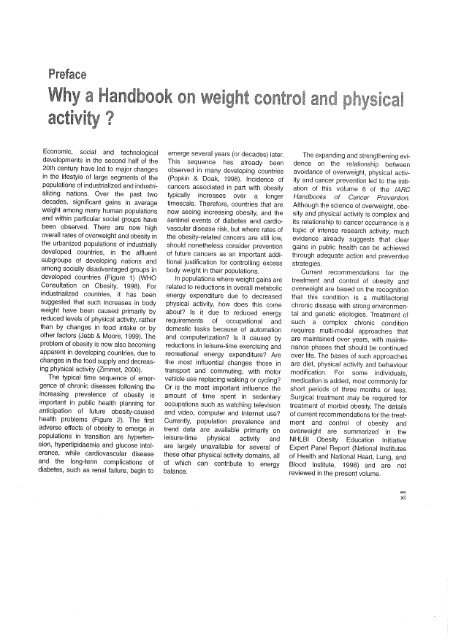IARC Handbooks of Cancer Prevention
IARC Handbooks of Cancer Prevention
IARC Handbooks of Cancer Prevention
You also want an ePaper? Increase the reach of your titles
YUMPU automatically turns print PDFs into web optimized ePapers that Google loves.
Preface<br />
hy a Handbook on weight control and physical<br />
activity ?<br />
Economic, social and technological<br />
developments in the second half <strong>of</strong> the<br />
20th century have led to major changes<br />
in the lifestyle <strong>of</strong> large segments <strong>of</strong> the<br />
populations <strong>of</strong> industrialized and industrializing<br />
nations. Over the past two<br />
decades, significant gains in average<br />
weight among many human populations<br />
and within particular social groups have<br />
been observed. There are now high<br />
overall rates <strong>of</strong> overweight and obesity in<br />
the urbanized populations <strong>of</strong> industrially<br />
developed countries, in the affuent<br />
subgroups <strong>of</strong> developing nations and<br />
among socially disadvantaged groups in<br />
developed countries (Figure 1) (WHO<br />
Consultation on Obesity, 1998). For<br />
industrialized countries, it has been<br />
suggested that such increases in body<br />
weight have been caused primarily by<br />
reduced levels <strong>of</strong> physical activity, rather<br />
than by changes in food intake or by<br />
other factors (Jebb & Moore, 1999). The<br />
problem <strong>of</strong> obesity is now also becoming<br />
apparent in developing countries, due to<br />
changes in the food supply and decreasing<br />
physical activity (Zimmet, 2000).<br />
The typical time sequence <strong>of</strong> emergence<br />
<strong>of</strong> chronic diseases following the<br />
increasing prevalence <strong>of</strong> obesity is<br />
important in public health planning for<br />
anticipation <strong>of</strong> future obesity-caused<br />
health problems (Figure 2). The first<br />
adverse effects <strong>of</strong> obesity ta emerge in<br />
populations in transition are hypertension,<br />
hyperlipidaemia and glucose Intolerance,<br />
while cardiovascular disease<br />
and the long-term complications <strong>of</strong><br />
diabetes, such as renal failure, begin to<br />
emerge several years (or decades) later.<br />
This sequence has already been<br />
observed in many developing countries<br />
(Popkin & Doak, 1998). Incidence <strong>of</strong><br />
cancers associated in part with obesity<br />
typically increases over a longer<br />
timescale. Therefore, countries that are<br />
now seeing increasing obesity, and the<br />
sentinel events <strong>of</strong> diabetes and cardiovascular<br />
disease risk, but where rates <strong>of</strong><br />
the obesity-related cancers are still low,<br />
should nonetheless consider prevention<br />
<strong>of</strong> future cancers as an important additional<br />
justification for controllng excess<br />
body weight in their populations.<br />
ln populations where weight gains are<br />
related to reductions in ove rail metabolic<br />
energy expenditure due to decreased<br />
physical activity, how does this come<br />
about? is it due ta reduced energy<br />
requirements <strong>of</strong> occupational and<br />
domestic tasks because <strong>of</strong> automation<br />
and computerization? is it caused by<br />
reductions in leisure-time exercising and<br />
recreational energy expenditure? Are<br />
the most influential changes those in<br />
transport and commuting, with motor<br />
vehicle use replacing walking or cycling?<br />
Or is the most important influence the<br />
amount <strong>of</strong> time spent in sedentary<br />
occupations such as watching television<br />
and video, computer and Internet use?<br />
Currently, population prevalence and<br />
trend data are available primarily on<br />
leisure-time physical activity and<br />
are largely unavailable for several <strong>of</strong><br />
these other physical activity domains, ail<br />
<strong>of</strong> which can contribute to energy<br />
balance.<br />
The expanding and strengthening evidence<br />
on the relationship between<br />
avoidance <strong>of</strong> overweight, physical activity<br />
and cancer prevention led to the initiation<br />
<strong>of</strong> this volume 6 <strong>of</strong> the <strong>IARC</strong><br />
<strong>Handbooks</strong> <strong>of</strong> <strong>Cancer</strong> <strong>Prevention</strong>.<br />
Although the science <strong>of</strong> overweight, obesity<br />
and physical activity is complex and<br />
its relationship to cancer occurrence is a<br />
topic <strong>of</strong> intense research activity, much<br />
evidence already suggests that clear<br />
gains in public health can be achieved<br />
through adequate action and preventive<br />
strategies.<br />
Current recommendations for the<br />
treatment and control <strong>of</strong> obesity and<br />
overweight are based on the recognition<br />
that this condition is a multifactorial<br />
chronic disease with strong environ<br />
mental<br />
and genetic etiologies. Treatment <strong>of</strong><br />
such a complex chronic condition<br />
requires multi-modal approaches that<br />
are maintained over years, with maintenance<br />
phases that should be continued<br />
over life. The bases <strong>of</strong> such approaches<br />
are diet, physical activity and behaviour<br />
modification. For some individuals,<br />
medication is added, most commonly for<br />
short periods <strong>of</strong> three months or less.<br />
Surgical treatment may be required for<br />
treatment <strong>of</strong> morbid obesity. The details<br />
<strong>of</strong> current recommendations for the treatment<br />
and control <strong>of</strong> obesity and<br />
overweight are summarized in the<br />
NHLBI Obesity Education Initiative<br />
Expert Panel Report (National Institutes<br />
<strong>of</strong> Health and National Heart, Lung, and<br />
Blood Institute, 1998) and are not<br />
reviewed in the present volume.<br />
xi

















